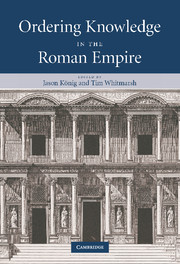Book contents
- Frontmatter
- Contents
- Preface
- Notes on contributors
- List of abbreviations
- Part I INTRODUCTION
- Part II KNOWLEDGE AND TEXTUAL ORDER
- Part III KNOWLEDGE AND SOCIAL ORDER
- 8 Knowledge and power in Frontinus' On aqueducts
- 9 Measures for an emperor: Volusius Maecianus' monetary pamphlet for Marcus Aurelius
- 10 Probing the entrails of the universe: astrology as bodily knowledge in Manilius' Astronomica
- 11 Galen's imperial order of knowledge
- Bibliography
- Index
9 - Measures for an emperor: Volusius Maecianus' monetary pamphlet for Marcus Aurelius
Published online by Cambridge University Press: 28 August 2009
- Frontmatter
- Contents
- Preface
- Notes on contributors
- List of abbreviations
- Part I INTRODUCTION
- Part II KNOWLEDGE AND TEXTUAL ORDER
- Part III KNOWLEDGE AND SOCIAL ORDER
- 8 Knowledge and power in Frontinus' On aqueducts
- 9 Measures for an emperor: Volusius Maecianus' monetary pamphlet for Marcus Aurelius
- 10 Probing the entrails of the universe: astrology as bodily knowledge in Manilius' Astronomica
- 11 Galen's imperial order of knowledge
- Bibliography
- Index
Summary
To the Greeks the Muse gave intellect and well-rounded speech; they are greedy only for praise.
Roman children, with lengthy calculations, learn to divide the as into a hundred parts.
(Horace, Ars Poetica 323–6)Like many clichés, Horace's sour depiction of Roman pragmatism has some truth to it – except that the Greeks were just as interested as the Romans in correctly dividing currency into parts. Metrology, the knowledge of measures of weight, length, volume and of money, was a major presence in ancient education and ancient life. The excavations of the Athenian agora have turned up some two hundred metrological objects. A great many papyri from Hellenistic and Roman Egypt are accounts, bills, or contracts stipulating sizes or weights of things. Texts such as the so-called Athenian coinage decree or the bilingual tax decree from Palmyra are expressions of political and economic decisions variously translated into metrological policies.
The act of measuring creates a correspondence between things in the real world and symbols, be they numbers, units of measurement, or signs representing numbers or units of measurement. For instance, the Palmyra decree enforces a correspondence between, say, a sack of salt and two symbols: a number expressing its volume, expressed in terms of modii (units of measurement), and another number, tied by decree to the first one, expressing the tax tariff in terms of duty per modius.
- Type
- Chapter
- Information
- Ordering Knowledge in the Roman Empire , pp. 206 - 228Publisher: Cambridge University PressPrint publication year: 2007
- 4
- Cited by



